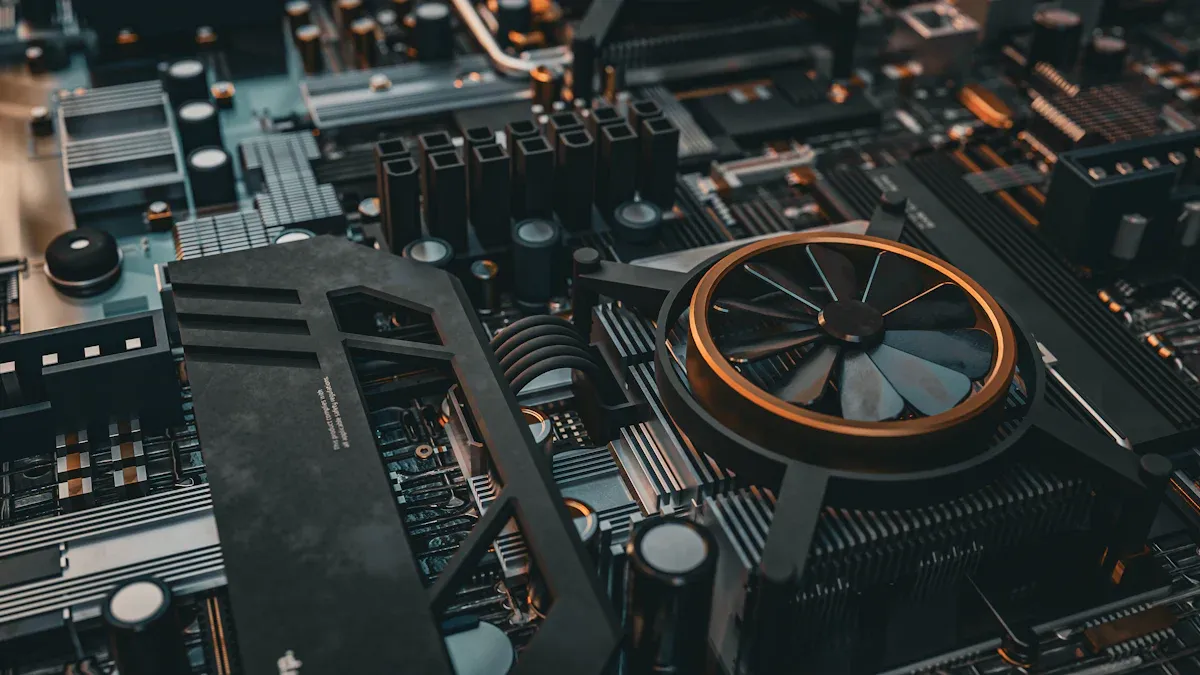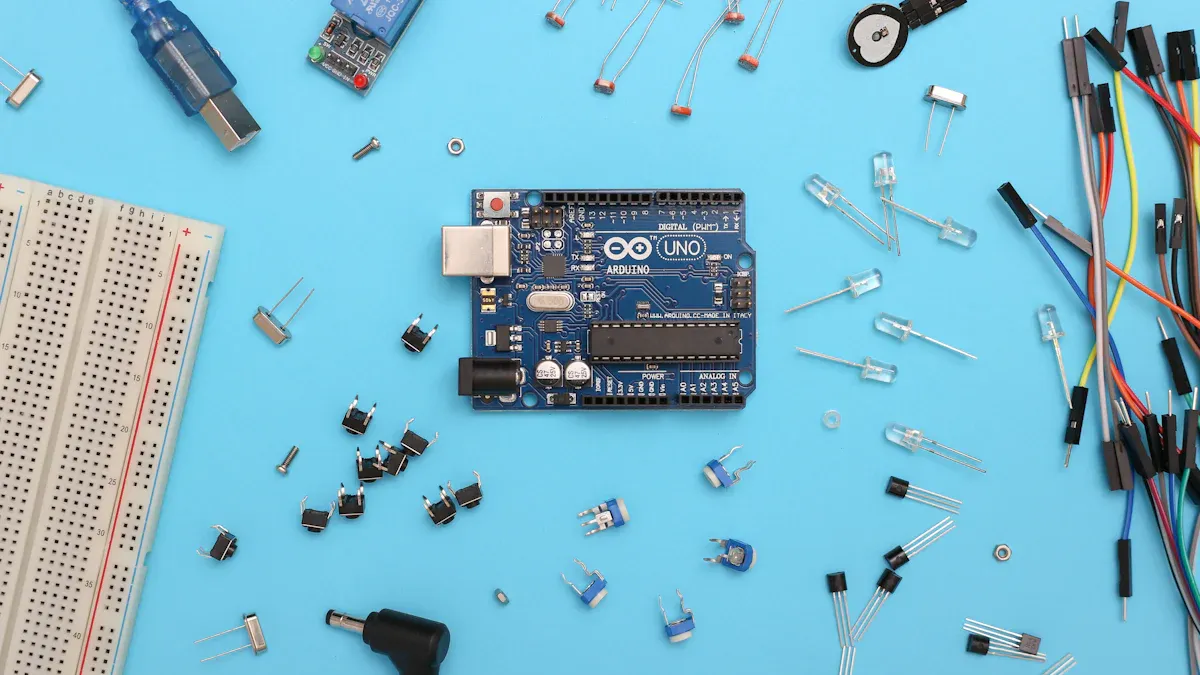How to Choose the Best SOT23-6 Buck Regulator Chip for Your Needs

Choosing the right SOT23-6 Buck Regulators Chip starts with understanding your system's needs. You should evaluate the voltage your circuit requires to operate efficiently. Check if your application demands a stable current supply under varying loads. Consider how much heat the chip generates and whether your design can manage it effectively. Efficiency matters too—higher efficiency reduces power loss and improves performance. Matching these factors with the chip's specifications ensures optimal operation for your project.
Key Takeaways
Know what your system needs. Check input and output voltages. Make sure the chip works with your circuit's voltages.
Look at how much current the chip can handle. Pick a chip with more current capacity than your circuit needs. This stops it from getting too hot.
Choose chips with efficiency over 90%. High efficiency saves power and keeps the chip cooler.
Check how the chip handles heat. Use heat sinks or special holes to keep it cool and working well.
Read the datasheet for details. It shows how the chip works, its limits, and extra features.
Understanding Application Requirements
Input Voltage Range
The input voltage range is one of the first things you should check when selecting a SOT23-6 Buck Regulators Chip. Every chip has a specific range of input voltages it can handle. If your power source provides voltage outside this range, the chip may fail or operate inefficiently.
To determine the right input voltage range:
Measure the voltage supplied by your power source.
Compare this value with the input voltage range listed in the chip's datasheet.
Ensure the chip can handle any fluctuations in your power source.
Tip: If your application involves batteries or renewable energy sources, choose a chip with a wide input voltage range to accommodate varying power levels.
Output Voltage Range
The output voltage range defines the voltage the chip can deliver to your circuit. This is crucial for ensuring your components receive the correct voltage to function properly.
To select the right output voltage range:
Identify the voltage requirements of your circuit.
Look for a SOT23-6 Buck Regulators Chip that can provide a stable output voltage within this range.
Check if the chip supports adjustable output voltage, which can offer flexibility for different applications.
Note: Some chips include feedback pins that allow you to fine-tune the output voltage. This feature can be helpful for precision applications.
Current Capacity
Current capacity refers to the maximum current the chip can supply to your load. If your circuit demands more current than the chip can provide, it may overheat or shut down.
To evaluate current capacity:
Calculate the total current required by your circuit.
Choose a chip with a current rating higher than your calculated value to ensure reliable operation.
Consider the chip's thermal performance, as higher currents can generate more heat.
Reminder: Always check the datasheet for information on peak and continuous current ratings. Continuous ratings are more relevant for long-term operation.
Efficiency Considerations
Efficiency plays a critical role in choosing the right SOT23-6 Buck Regulators Chip. Higher efficiency reduces power loss, minimizes heat generation, and extends the lifespan of your components. When evaluating efficiency, focus on how the chip performs under different operating conditions.
To assess efficiency:
Look for chips with efficiency ratings above 90%. For example, the SC120 buck regulator chip achieves up to 94% efficiency, making it ideal for applications requiring minimal energy waste.
Check the datasheet for efficiency curves. These graphs show how the chip performs across varying input voltages, output loads, and switching frequencies.
Consider your application's typical operating conditions. If your circuit operates at low loads or fluctuating voltages, choose a chip optimized for these scenarios.
Tip: Efficiency ratings often peak at specific load levels. Select a chip that aligns with your circuit's average load to maximize performance.
Thermal Management
Thermal management ensures the chip operates reliably without overheating. Excessive heat can degrade performance, shorten the chip's lifespan, or even cause failure. Proper thermal design is essential, especially for compact packages like SOT23-6.
To manage heat effectively:
Review the chip's thermal resistance in the datasheet. Lower thermal resistance means better heat dissipation.
Use heat sinks or thermal vias in your PCB design to improve cooling.
Avoid exceeding the chip's maximum junction temperature. Operating within safe limits prevents thermal shutdowns and ensures long-term reliability.
Reminder: Chips with higher efficiency generate less heat, reducing the need for extensive thermal management.
Thermal performance also depends on your application's environment. If your design operates in high-temperature conditions, choose a chip with robust thermal characteristics.
Assessing SOT23-6 Buck Regulators Chip Specifications

Key Datasheet Parameters
When choosing a SOT23-6 Buck Regulators Chip, the datasheet is your best resource. It contains all the technical details you need to make an informed decision. Pay close attention to the following parameters:
Input Voltage Range: Confirm that the chip supports the voltage supplied by your power source.
Output Voltage Range: Check if the chip can deliver the voltage your circuit requires.
Current Rating: Ensure the chip can handle the current demands of your application.
Efficiency: Look for efficiency ratings that match your design goals.
The datasheet also includes graphs and tables that show how the chip performs under different conditions. Use these to evaluate its behavior in your specific setup.
Tip: Always review the "Absolute Maximum Ratings" section in the datasheet. Exceeding these limits can damage the chip permanently.
Switching Frequency
Switching frequency is another critical factor to consider. It determines how fast the chip switches between on and off states to regulate voltage. Higher switching frequencies allow smaller external components, like inductors and capacitors, which can save space in your design.
To choose the right switching frequency:
Check the frequency range listed in the datasheet.
Match the frequency to your application's requirements.
Consider the trade-offs. Higher frequencies may increase efficiency but can also generate more electromagnetic interference (EMI).
Note: Some SOT23-6 Buck Regulators Chips offer adjustable switching frequencies. This feature lets you optimize performance for your specific needs.
Package Thermal Resistance
Thermal resistance measures how well the chip dissipates heat. For SOT23-6 Buck Regulators Chips, this is especially important due to their compact size. Lower thermal resistance means the chip can handle higher power levels without overheating.
To assess thermal resistance:
Look for the "Thermal Resistance Junction-to-Ambient" value in the datasheet.
Compare this value with your application's cooling capabilities.
Use thermal management techniques like heat sinks or PCB thermal vias to improve heat dissipation.
Reminder: Operating the chip within its thermal limits ensures reliable performance and extends its lifespan.
By understanding these specifications, you can select a SOT23-6 Buck Regulators Chip that meets your design requirements while maintaining efficiency and reliability.
Additional Features
When selecting a SOT23-6 Buck Regulators Chip, additional features can significantly impact your design's performance and flexibility. These features go beyond basic specifications and provide added functionality that can simplify your design or enhance reliability.
Synchronization Capability
Some chips offer synchronization capability, allowing you to externally synchronize the switching frequency with other components in your circuit. This feature minimizes electromagnetic interference (EMI) and ensures stable operation in complex systems. If your design involves multiple switching regulators, synchronization can help maintain harmony between them.
Shutdown Mode
Shutdown mode is a feature that reduces power consumption when the chip is not actively regulating voltage. For example, the LT1172 chip consumes only 50μA in shutdown mode, making it ideal for battery-powered applications. This feature helps extend battery life and reduces energy waste in idle states.
Overload Protection
Overload protection ensures the chip can handle unexpected current spikes without permanent damage. Self-protected chips, like the LT1172, automatically limit current during overload conditions. This feature enhances reliability and prevents costly failures in your design.
External Parts Requirement
The number of external components required by a chip affects design complexity and cost. Chips with minimal external parts simplify assembly and reduce the risk of errors. For instance, the LT1172 requires very few external components, making it a convenient choice for compact designs.
Feature Comparison Table
To help you evaluate additional features, here’s a comparison of the LT1172 chip specifications:
Feature | |
|---|---|
Input Voltage Range | 3V to 60V |
Quiescent Current | 6mA |
Internal Switch Current | 5A (2.5A for LT1171, 1.25A for LT1172) |
Shutdown Mode Current | 50μA |
External Parts Requirement | Very Few |
Overload Protection | Self-Protected |
Switching Topologies Supported | Nearly All |
Package Options | 8-Pin MiniDIP, Surface Mount |
Synchronization Capability | Externally Synchronized |
Load Power Delivery | Up to 100W |
Efficiency Technique | Adaptive antisat switch drive |
This table highlights key features that can simplify your design, improve efficiency, and enhance reliability.
Adaptive Efficiency Techniques
Some chips incorporate advanced efficiency techniques, such as adaptive antisaturation switch drive. This feature optimizes power delivery and minimizes energy loss, ensuring your circuit operates efficiently under varying loads.
Tip: Prioritize chips with features that align with your application needs. For example, if your design requires high power delivery, choose a chip with robust overload protection and adaptive efficiency techniques.
By considering these additional features, you can select a SOT23-6 Buck Regulators Chip that not only meets your basic requirements but also adds value to your design.
Practical Selection Criteria

Availability and Cost
When choosing a SOT23-6 buck regulator chip, availability and cost play a significant role. You need to ensure the chip is readily available in your region or through reliable distributors. Delays in sourcing components can disrupt your project timeline.
Cost is another critical factor. Prices for these chips can vary based on raw material costs, manufacturing processes, and market demand. For example, silicon wafer prices increased by 20% between 2021 and 2023, impacting production costs. However, advancements like transitioning from 8-inch to 12-inch fabrication lines have reduced per-die costs by up to 34%.
Here’s a quick overview of market trends:
Factor | Impact |
|---|---|
Raw Material Cost Impact | Silicon wafer prices rose 20% (2021-2023). |
Manufacturing Efficiency | 12-inch fab lines cut per-die costs by 28-34%. |
Price Decline in Consumer Segment | IoT-grade chips saw a 9% price drop due to smaller die sizes. |
Regional Manufacturing Initiatives | India offers 8-12% cost savings for basic variants. |
By understanding these trends, you can balance cost and availability to make an informed decision.
Manufacturer Documentation
Reliable manufacturer documentation simplifies the selection process. Datasheets, application notes, and design guides provide essential details about the chip's performance and limitations. Look for clear and comprehensive documentation that includes:
Electrical specifications like input/output voltage ranges and current ratings.
Efficiency curves and thermal resistance data.
Application examples to guide your design.
Some manufacturers also offer simulation tools or reference designs. These resources help you test the chip's performance in your circuit before committing to a purchase.
Tip: Choose chips from manufacturers with a reputation for detailed and accurate documentation. This ensures you have the support needed for a successful design.
Design Simplicity
Design simplicity can save you time and reduce errors. Some SOT23-6 buck regulator chips require fewer external components, making them easier to integrate into your circuit. For instance, chips with built-in compensation or adjustable output voltage reduce the need for additional parts.
Simpler designs also improve reliability. Fewer components mean fewer potential points of failure. Additionally, compact designs save PCB space, which is crucial for portable or space-constrained applications.
Reminder: Prioritize chips that align with your design goals while minimizing complexity. This approach ensures a smoother development process and a more robust final product.
Choosing the right SOT23-6 buck regulator chip starts with understanding your application’s needs. Matching voltage, current, and thermal requirements with chip specifications ensures reliable performance.
Balancing performance, cost, and design simplicity helps you achieve an efficient and practical solution. Chips with fewer external components simplify your design while saving time and space.
Tip: Use datasheets and manufacturer resources to guide your decision. These tools provide valuable insights into chip behavior and compatibility with your circuit.
By following these steps, you can select a chip that meets your goals and enhances your project’s success.
FAQ
What is the main advantage of using a SOT23-6 buck regulator chip?
SOT23-6 buck regulator chips offer a compact size, making them ideal for space-constrained designs. They also provide high efficiency and reliable voltage regulation, which helps reduce power loss and heat generation in your circuit.
How do I calculate the required current capacity for my application?
Add up the current demands of all components in your circuit. Choose a chip with a current rating higher than this total to ensure stable operation. Always check the datasheet for continuous current ratings, as these are more relevant for long-term use.
Can I use a SOT23-6 chip for high-power applications?
SOT23-6 chips are best suited for low to medium power applications due to their compact size and thermal limitations. For high-power needs, consider chips with larger packages or enhanced thermal management features.
What happens if I exceed the chip’s input voltage range?
Exceeding the input voltage range can damage the chip or cause it to malfunction. Always ensure your power source stays within the specified range in the datasheet. Use voltage protection circuits if your power source fluctuates significantly.
Are adjustable output voltage chips better than fixed ones?
Adjustable chips offer more flexibility, allowing you to fine-tune the output voltage for different applications. Fixed-output chips simplify design and reduce external components. Choose based on your project’s complexity and voltage requirements.
Tip: If you’re unsure, start with an adjustable chip for greater versatility.
See Also
Selecting The Ideal Low-Power Microcontroller For Your Needs
Exploring Applications Of Single Darlington Transistor ICs
A Guide To Battery Charger Controller IC Applications
